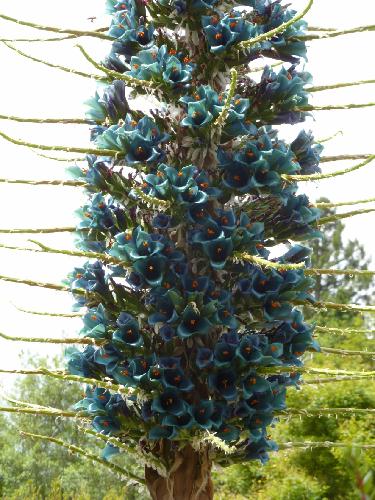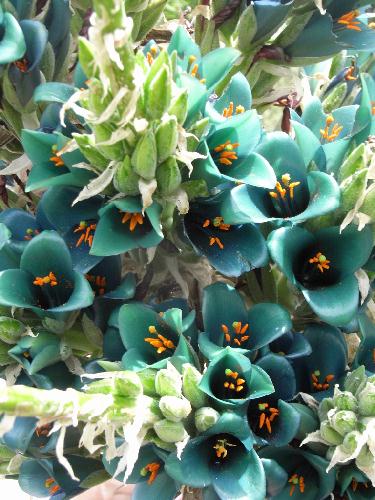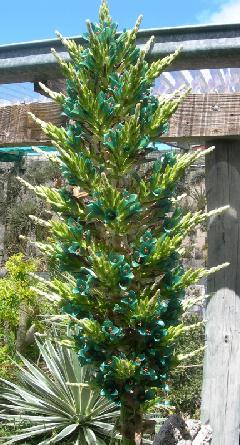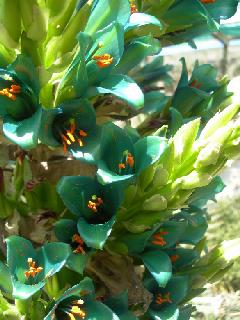



Mt Tomah Botanic Gardens, NSW Ian Hook 11/11. |
Victoria Chris Larson 11/06. |
This is where the problem starts. In 1896 Mez decided to describe parts of a plant that had been found near Valparaiso in Chile by Carlos Bertero. Let us remember the transport situation at that time and ponder on the thoughts of such a collector. “How am I going to get this thing out of the wild – I’ll just collect as much material as I am able!” Mez decided it had a totally fertile inflorescence and described Puya berteroniana which was subsequently placed under subgenus Pitcairniopsis which eventually became subgenus Puyopsis. As a side issue, current molecular studies are showing that the old notion that Pitcairnia and Puya are closely related is in error. Back to the plot. In 1935 in Das Pflanzenreich, Mez still had Puya berteroniana under Pitcairniopsis. In the same year Lyman Smith entered the arena and he was convinced an error had been made possibly because all the plants being found in the wild near Valparaiso that could be linked to P. berteroniana had an inflorescence that had cocky perches! Surely Mez had made a mistake.
So, up to 2013 we had P. berteroniana for the large plant found around Valparaiso and the more southerly smaller plant known as P. alpestris.
Was Bertero 115 a one off – a natural hybrid or mutation? Had Lyman Smith and all the subsequent writers made wrong assumptions? Georg Zizka and his co-workers thought so and we see details published in Brittonia 65(4): 387-407. 2013.
So, now we have P. berteroniana treated as P. x berteroniana and NOT in cultivation and a new P. alpestris subsp. zoellneri to take its place.
Just think, the next time you are in a Botanical Garden and you see a plant with Puya berteroniana on the label you can flash a copy of this article to put them on the right path!
Finally a few words on natural hybrids. In Brittonia 65(4): 387-407. 2013. We find:
‘However, Puya berteroniana Mez is here regarded to be a very rare taxon of hybrid origin. Up to now, Puya hybrids have been only reported by Luther (2010) who listed two species of hybrid origin (P. x loxensis Manzanares & W. Till, P. x pichinchae Mez & Sodiro), but no hybrids between representatives of different subgenera have been recorded up to now. However, a hybrid between the genera Puya and Deuterocohnia, x Pucohnia G.H. Anderson ex D.A. Beadle, was published by Beadle (1991).’
Natural hybrids are generally on the backburner as far as botanists are concerned and many are referred to just by parental formula, and the only place they are listed is http://botu07.bio.uu.nl/bcg/taxonList.php. Just search on nat hyb to get a list. It is also possible if only one plant is found that the difference can be explained by mutation but we still treat it a natural hybrid with putative parents. It should be noted here that the parental species names are in alphabetical order to easily check on double entries because in natural hybrids nobody knows for sure which is the seed parent. There are also many natural hybrids that have been declared but nobody has bothered to publish the name with a multiplication sign.
The citation ‘Beadle (1991)’ may be referrable by the academic botanist who has easy access to University libraries but mention could have been made to the Bromeliad Cultivar Register http://botu07.bio.uu.nl/bcg/bcr/index.php where easy access to this information is available.




Mt Tomah Botanic Gardens, NSW Ian Hook 11/11. |
Victoria Chris Larson 11/06. |